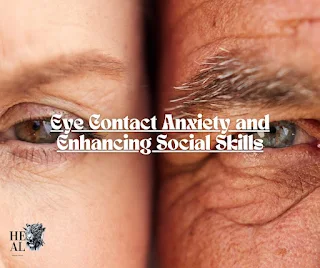Eye Contact Anxiety and Enhancing Social Skills
Eye contact anxiety refers to the unease individuals feel when looking directly into someone’s eyes. Those affected may avoid eye contact during conversations, fearing judgment or scrutiny. This discomfort can hinder social interactions, making it challenging for individuals, especially those with shyness or social anxiety, to maintain good eye contact.
Understanding Eye Contact Anxiety
Even without a diagnosed anxiety disorder, some people may find eye contact anxiety troubling. To build tolerance, gradual exposure and the application of strategies like the 50/70 rule, looking away slowly, and using the triangle technique can be beneficial.
Exploring Reasons for Avoidance
Eye contact anxiety can stem from various sources, including shyness or a lack of confidence, particularly for those not accustomed to conversations or spotlight situations. In cases where anxiety may be related to a diagnosed disorder, seeking guidance from a mental health professional is recommended.
Eye Contact and Social Anxiety
Individuals with social anxiety disorder (SAD) often find direct eye contact anxiety-provoking due, in part, to genetic factors. Research indicates a pronounced fear of eye contact in individuals with SAD, triggering the amygdala’s danger response. Socially anxious individuals may avoid maintaining eye contact, fearing judgment in social situations.
Eye Contact and Autism
For individuals with autism, hypersensitivity to eye contact can lead to discomfort and pain. Studies reveal heightened brain activity in response to facial expressions, prompting avoidance of eye contact.
The Power of Eye Contact
Maintaining eye contact during conversations holds significance in personal and professional relationships. Benefits include being more memorable, credible, and better at conveying confidence and intelligence. Overcoming eye contact anxiety involves reducing anxiety, improving eye contact skills, and practicing exposure.
Reducing Anxiety About Eye Contact
Treatment options, including cognitive-behavioral therapy (CBT) or medication, can benefit those with diagnosed anxiety disorders. Gradual exposure, starting with less anxiety-inducing situations, and practicing eye contact in various contexts can help desensitize individuals to this social interaction aspect.
Improving Eye Contact Skills
When engaged in one-on-one conversations, selecting a spot between or slightly above the listener’s eyes, or letting the eyes go slightly out of focus, can enhance comfort. Occasional breaks in eye contact, looking away slowly, and employing strategies like the 50/70 rule contribute to natural and effective communication.
Tips for Making Eye Contact
Establishing eye contact at the conversation’s start, using the 50/70 rule, and holding eye contact for 4–5 seconds are effective techniques. Looking away slowly, using the triangle technique, making gestures, and focusing near the eyes can enhance connection and comfort during conversations.
Enhancing Public Speaking Skills
When addressing a group, imagining individual conversations with each person and making eye contact accordingly fosters a sense of connection. This approach ensures inclusion and a comfortable speaking experience for both the speaker and the audience.

